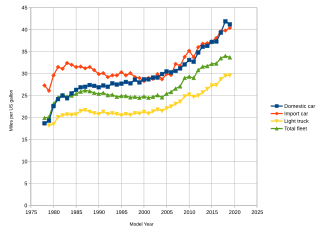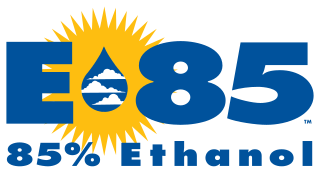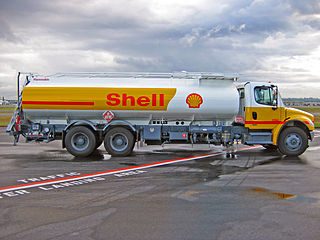
The Grumman Long Life Vehicle (LLV) is an American light transport truck model, designed as a mail truck for the United States Postal Service, which has been its primary user since it first entered service in 1987, 36 years ago. It also was used by Canada Post. The LLV uses a chassis built by GM based on the S-10 with an aluminum body built by Grumman.

Corporate average fuel economy (CAFE) standards are regulations in the United States, first enacted by the United States Congress in 1975, after the 1973–74 Arab Oil Embargo, to improve the average fuel economy of cars and light trucks produced for sale in the United States. More recently, efficiency standards were developed and implemented for heavy-duty pickup trucks and commercial medium-duty and heavy-duty vehicles.

The Ford Escape is a compact crossover SUV sold by Ford since the 2001 model year. The first Ford SUV derived from a car platform, the Escape was slotted below the Ford Explorer in size; the Escape is currently sized between the Ford EcoSport and Ford Edge. In another first, the 2004 Ford Escape Hybrid was the first hybrid-electric vehicle from Ford, and the first hybrid produced as an SUV.

The Ford Fusion Hybrid is a gasoline-electric hybrid powered version of the mid-sized Ford Fusion sedan manufactured and marketed by Ford, now in its second generation. A plug-in hybrid version, the Ford Fusion Energi, was released in the U.S. in February 2013.

The Ford C-Max is a car produced by the Ford Motor Company from 2003 to 2019. It has a five-door compact multi-purpose vehicle (MPV) design. The Ford Grand C-Max has a longer wheelbase.

E85 is an abbreviation typically referring to an ethanol fuel blend of 85% ethanol fuel and 15% gasoline or other hydrocarbon by volume.

A flexible-fuel vehicle (FFV) or dual-fuel vehicle is an alternative fuel vehicle with an internal combustion engine designed to run on more than one fuel, usually gasoline blended with either ethanol or methanol fuel, and both fuels are stored in the same common tank. Modern flex-fuel engines are capable of burning any proportion of the resulting blend in the combustion chamber as fuel injection and spark timing are adjusted automatically according to the actual blend detected by a fuel composition sensor. This device is known as an oxygen sensor and it reads the oxygen levels in the stream of exhaust gasses, its signal enriching or leaning the fuel mixture going into the engine. Flex-fuel vehicles are distinguished from bi-fuel vehicles, where two fuels are stored in separate tanks and the engine runs on one fuel at a time, for example, compressed natural gas (CNG), liquefied petroleum gas (LPG), or hydrogen.

A tank truck, gas truck, fuel truck, or tanker truck or tanker is a motor vehicle designed to carry liquids or gases on roads. The largest such vehicles are similar to railroad tank cars, which are also designed to carry liquid loads. Many variants exist due to the wide variety of liquids that can be transported. Tank trucks tend to be large; they may be insulated or non-insulated; pressurized or non-pressurized; and designed for single or multiple loads. Some are semi-trailer trucks. They are difficult to drive and highly susceptible to rollover due to their high center of gravity, and potentially the free surface effect of liquids sloshing in a partially filled tank.
Utilimaster, a subsidiary of The Shyft Group, manufactures multi-stop trucks. It was founded in 1973 in Wakarusa, Indiana.

A post van is a type of delivery vehicle that is used to transport post. Originally horse-drawn, most modern mail trucks are automotive vehicles.

The fuel economy of an automobile relates to the distance traveled by a vehicle and the amount of fuel consumed. Consumption can be expressed in terms of the volume of fuel to travel a distance, or the distance traveled per unit volume of fuel consumed. Since fuel consumption of vehicles is a significant factor in air pollution, and since the importation of motor fuel can be a large part of a nation's foreign trade, many countries impose requirements for fuel economy. Different methods are used to approximate the actual performance of the vehicle. The energy in fuel is required to overcome various losses encountered while propelling the vehicle, and in providing power to vehicle systems such as ignition or air conditioning. Various strategies can be employed to reduce losses at each of the conversions between the chemical energy in the fuel and the kinetic energy of the vehicle. Driver behavior can affect fuel economy; maneuvers such as sudden acceleration and heavy braking waste energy.
The United States produces mainly biodiesel and ethanol fuel, which uses corn as the main feedstock. The US is the world's largest producer of ethanol, having produced nearly 16 billion gallons in 2017 alone. The United States, together with Brazil accounted for 85 percent of all ethanol production, with total world production of 27.05 billion gallons. Biodiesel is commercially available in most oilseed-producing states. As of 2005, it was somewhat more expensive than fossil diesel, though it is still commonly produced in relatively small quantities.
E85 is an abbreviation for an ethanol fuel blend of between 51% and 83% denatured ethanol fuel and gasoline or other hydrocarbon (HC) by volume.

The M35 2½-ton cargo truck is a long-lived 2½-ton 6×6 cargo truck initially used by the United States Army and subsequently utilized by many nations around the world. Over time it evolved into a family of specialized vehicles. It inherited the nickname "Deuce and a Half" from an older 2½-ton truck, the World War II GMC CCKW.

An alternative fuel vehicle is a motor vehicle that runs on alternative fuel rather than traditional petroleum fuels. The term also refers to any technology powering an engine that does not solely involve petroleum. Because of a combination of factors, such as environmental and health concerns including climate change and air pollution, high oil-prices and the potential for peak oil, development of cleaner alternative fuels and advanced power systems for vehicles has become a high priority for many governments and vehicle manufacturers around the world.

The M970 Semi-Trailer Refueler is a 5,000-U.S.-gallon fuel dispensing tanker designed for under/overwing refueling of aircraft. It is equipped with a filter/separator, recirculation system and two refueling systems, one for underwing and one for overwing servicing. The tanker is designed to be towed by a 5-ton, 6x6 truck tractor or similar vehicle equipped with a fifth wheel. The M970 can be loaded through the bottom or through the top fill openings. A ladder is provided at the front of the semitrailer for access to the top manhole, and a 4-cylinder diesel engine and pump assembly provides self load/unload capability. The body of the refueler is a 5,000-U.S.-gallon, single compartment, stainless steel tank. The chassis is of welded steel construction and is equipped with full floating tandem axles and a manually operated landing gear. There has been talk of retiring the M970, but a suitable off-road replacement has not been found. The Marine Corps also uses R-9 and R-10 tankers, but they are not capable of off road use. The M970 is a part of the "United States Marine Corps Maintenance Center - Albany, Georgia, USA - An Integrated Enterprise Scheduling Case Study" which is working to upgrade the Semitrailer for future use.

Miles per gallon gasoline equivalent is a measure of the average distance traveled per unit of energy consumed. MPGe is used by the United States Environmental Protection Agency (EPA) to compare energy consumption of alternative fuel vehicles, plug-in electric vehicles and other advanced technology vehicles with the energy consumption of conventional internal combustion vehicles rated in miles per U.S. gallon.
The fleet of flexible-fuel vehicles in the United States is the second largest in the world after Brazil, and there were more than 21 million 85 flex-fuel vehicles registered in the country by the end of 2017. Despite the growing fleet of E85 flex-fuel vehicles, actual use of ethanol fuel is limited due to the lack of E85 refueling infrastructure and also because many North American flex-fuel car owners were not aware they owned an E85 flex-fuel vehicle. Flex-fuel vehicles are common in the Midwest, where corn is a major crop and is the primary feedstock for ethanol fuel production. Also the U.S. government has been using flex-fuel vehicles for many years.

The OshkoshNext Generation Delivery Vehicle (NGDV) will be a mail truck for the United States Postal Service (USPS). The contract award, made to Oshkosh Defense, a wholly-owned subsidiary of Oshkosh Corporation, in February 2021, is valued at $6 billion. Up to 160,000 vehicles will be built in a new facility. Four variants of the NGDV are expected to be in fleet use: both gasoline-powered and battery-electric, driving either the front wheels or all four wheels. The USPS will begin to receive the vehicles in June 2024.

The Workhorse C-Series was a line of battery electric medium-duty delivery vans built by Workhorse Group for commercial package delivery company fleets, which entered limited production in 2021, were recalled that September, and were discontinued in 2022 after fewer than fifty were built. The C-Series was originally named the N-GEN when the line was first announced in 2017. N-GEN prototypes began testing in 2018 and were renamed to the C-Series in 2019.


















